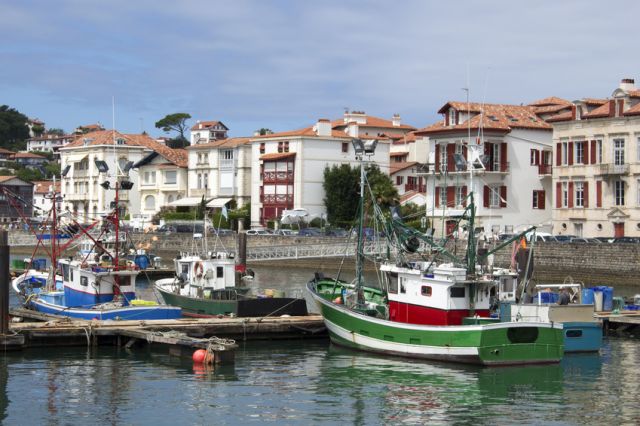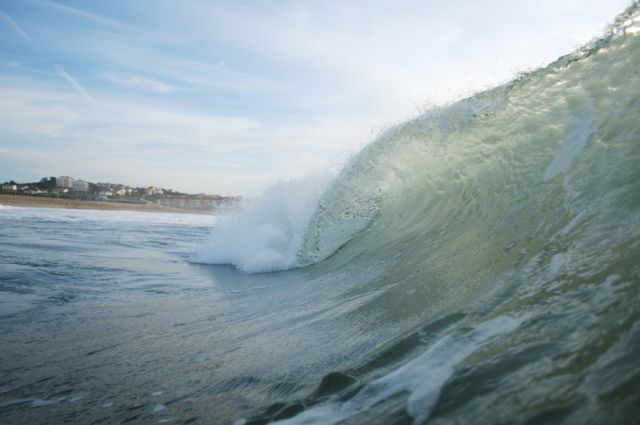- Home page
- Tourism
- Discover
- Visiting the Basque Country
- Labourd
- Visiting the Basque Country
- Discover
- Tourism
Labourd
Automatic translation

"LAPURDI"
This is the maritime facade of the Basque Country, which extends from the borders of Gascony to the Pyrenees and Spain, from the long beaches of the South of Landes to Anglet to the steep coasts starting at Biarritz and stretching to Hendaye, with the typical folded and steep flysch cliffs.
Labourd is a coastal strip approximately 10 km wide dotted with famous seaside resorts and typical ports such as Biarritz, Hendaye, and Saint Jean de Luz, not forgetting Bayonne, the gateway to the Basque Country and the confluence of two rivers, the Nive and the Adour.
But Labourd draws its undeniable charm above all from its many small, typical inland towns such as Ascain, Sare, Ainhoa, Espelette and its famous chilli pepper, which in the middle of green landscapes present their traditional rural architecture made up of superb green and red Labourdine houses, squares and their pediments, churches with galleries...
Our good plan: The little train of Biarritz for a pleasant 30-minute visit. The departure is either at the Grande Plage or in front of the rock of the Virgin. Headsets are available to hear more clearly the comments about Biarritz. Beach, visits, games, gastronomy, local produce, the whole Basque Country is concentrated in Biarritz!
history
Attracted by the mild climate, the first traces of human occupation in the region are very old, as evidenced by the numerous dolmens and rock shelters.
First under Celtic and then Roman tutelage, evangelized by Saint Leo in the Middle Ages, after having been part of Aquitaine, Labourd will remain under English domination for a long time. This will be the time of the rise of the Basque ports and their merchant trade. There we rub shoulders with whale fishermen, pirates who will build superb residences testifying to their enrichment, and more generally merchant sailors, very appreciated by the kings of England. Labourd therefore experiences a real boom at this time.
After Joan of Arc drove the English out of France, Labourd became French again and hosted the marriage of Louis XIV and the Infanta in 1160 in Saint-Jean-de-Luz.
Under the Ancien Régime, while Bayonne lived under "Customary" law, the rest of the region was under the "Labourd custom", but it was above all the revolution and the administrative redistribution of the territory that would change the situation. The Basque Country, from this date, will be part of the department of Basses Pyrénées which will later become the Pyrénées Atlantiques.
In the region, a nationalist will will not stop growing, exacerbated on the Spanish side. On the French side, there is still a demand today for the birth of a French Basque Country department including Labourd and its former sister provinces, Lower Navarre and Soule.
ploughing today
In the past, Labourd attracted less attention than neighbouring Navarre, which had a more eventful history and development. Today, it is the major region of the Basque Country for:
- Its rapid tourist boom which began with the arrival of paid holidays and seaside tourism.
- The parallel development of luxury tourism driven by artists and other personalities who very quickly made the region a very popular place by settling there.
This is how, on a narrow coastal strip, we now find world-famous seaside resorts such as Biarritz.
This part of the Basque Country is highly sought after for its art of living, its gastronomy (Bayonne ham, chocolate, Espelette pepper, cuisine with both Gascon and Spanish aromas), its popular festivals, its architectural identity, its typical villages and above all its cultural identity conveyed today by new vectors such as surfing, the new icon of the Basque Country and in particular of Labourd.
Our good plan: if you are passing through Bayonne, remember to visit the cloister of the cathedral. Entrance is free, from 9 a.m. to 12:30 p.m. and from 2 p.m. to 6 p.m. It is pleasant to walk there. It is calm and relaxing and a pleasure for all lovers of old stone.
surfing
Although surfing has its origins in the Pacific in Hawaii and Tahiti, it has become one of the economic and sporting emblems of the Basque Country today.
His story
Surfing arrived in the Basque Country via the United States.
- It was in 1957 that the American director Peter Viertel, while filming "The Sun Also Rises", was seduced by the Basque waves and brought his board.
- In 1959, the first French surf club was created in Biarritz.
- While the most popular spots and championships were still outside France, in 1963, the first French Internationals were organized in La Barre at the mouth of the Adour.
- In the 1960s, around ten surf clubs were created in the Basque Country.
Surfing events in the Basque Country
Today, Biarritz hosts the first surfing competition on the European calendar in April, the Biarritz Maïder Arosteguy. In August, Anglet, another big spot on the coast, hosts the WQS ProAnglet. Not to mention the French Surfing Championship which takes place in October in Biarritz.
But surfing in the Basque Country is also a whole culture, with its festivals that punctuate the summer, including the famous Big Festival in Biarritz or the International Surf Film Festival in Anglet, without forgetting Festilasai and the Baleapop Festival in Saint Jean de Luz.
The best spots in the Basque Country are today in Anglet, Biarritz, Bidart, Guethary, and Saint Jean de Luz.
Information on the Belharra Wave : it forms in the fall and winter off the Basque coast. It is the only giant wave in Europe. Its name refers to the underwater rocky spur that allows it to form in certain very specific climatic conditions. It can then reach 10 to 15 m high! But be careful : it can only be surfed by professional surfers pulled by jet skis.
You can find all the surfing information from the Basque Coast on Surf Report.

(Photo illustration: La Vague Basque Surf School)
Bayonne ham
Already known in the Middle Ages, this famous culinary specialty also finds its references in the literature of Rabelais. Rubbed with salt from the Adour basin and Espelette pepper, covered with salt and hung in the open air for 7 to 10 months to dry, Bayonne Ham is now subject to very precise quality standards to deserve the name "Bayonne Ham". Discover every year at Easter during the big ham fair on the Place du Réduit in Bayonne, the traditional hams of the small Basque pork butchers.
Check out our good addresses for ham, charcuterie and cured meats from the Basque Country.

Our tip: We went to discover a shop specializing in Bayonne ham and Basque regional products. Read about it on the blog!
Espelette pepper
Imported from Mexico and Colombia to Europe via Spain, the chili pepper arrived in the Basque Country to initially serve to spice up... chocolate ! Today, it is the emblem of the French Basque Country and is highly sought after by all the great chefs of gastronomy, well beyond Labourd and the Basque Country.
Espelette is a village that turns red in September when bunches of peppers are hung on the facades of houses to dry them. It's a sight not to be missed! In fact, every year, thousands of people invade Espelette for the traditional Pepper Festival ! Since the 1960s, around thirty producers have been growing the pepper that obtained the AOC designation in 1999.
It even seems that, in addition to its taste qualities, Espelette pepper has, according to the elders, curative virtues !
Our good plan: The Bipertegia boutique is located on the Place du Jeu de Paume in Espelette. You can also meet the producers at the market, every Wednesday morning!
Our favorite: the praline spread with Espelette pepper. And you?
Chocolate
Chocolate arrived from America via the Basque ports. This is why, given the importance of this trade, factories were created in Bayonne and Biarritz.
Discover the secrets of chocolate making at the chocolate workshop in Bayonne or the PUYODEBAT Chocolate Factory-Museum in Cambo-les-Bains.
Several renowned Basque chocolate manufacturers are also worth a visit.
Rugby
Rugby in the Basque Country is a culture embodied by two enemy brother clubs:
- Biarritz Olympique or BO: 4 national titles since 2000, participations in the European Cup...
- Aviron Bayonnais, its popular charisma and its pre-match atmosphere will give you goosebumps.
Let's not forget the other clubs in the region either, and God knows there are many of them!

Photo Credits ©Fotolia
Venta Biok
Venta Biok
BIOK Experiential Shopping - Quality at the best price We welcome you to BIOK Shopping Centers! Located in the ...
Dantxarinea
Bizipoz bar
Bizipoz bar
Discover the Bizipoz Bar, your new unique place to live on the Basque Coast! The BIZIPOZ BAR is an intergenerational ...
Saint-Jean-de-Luz
Jump Academy Bayonne
Jump Academy Bayonne
Come and discover your Jump Academy park for a pure moment of madness with family or friends! A 1500m² playground ...
Saint-Pierre-d'Irube
OUR CITY GUIDES IN EUROPE
By continuing to navigate, you authorize the deposit of third-party cookies for audience measurement purposes.
Some pages of the site offer videos whose platforms also deposit cookies.







